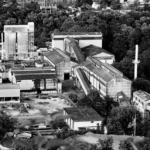The Environmental Protection Department was “more prepared” than it was when Super Typhoon Mangkhut hit Hong Kong five years ago, according to Friends of the Earth, but the government’s recycling efforts were still far from enough.
Green groups have called on the government’s only wood processing plant to step up recycling operations and improve transparency after only 15 percent of tree waste collected in the wake of Super Typhoon Saola was deemed suitable for recycling.
For the first time since Super Typhoon Mangkhut struck Hong Kong in September 2018, Saola caused the Hong Kong Observatory to issue its highest storm signal on September 1.
Responding to inquiries from HKFP, a spokesperson for the Development Bureau said the government had received 3,700 reports of fallen or broken trees after Saola. The resulting debris was sent to temporary tree waste collection areas in the Kai Tak Development Area, South East New Territories Landfill, West New Territories Landfill, and North East New Territories Landfill, and garden waste recycling plant Y Park, the bureau said.
According to the Environmental Protection Department, the amount of tree waste generated was about 1,800 tonnes, most of which was twigs, small branches, and leaves.
The department estimated that about 270 tons of the tree waste percent—could be recycled and would be delivered to Y Park for processing.

also read-Problem Of Diabetes in Dogs: Diabetes Can Also Affect Your Best Friend.
Typhoon
“Y Park is equipped with different processing equipment, such as wood crushers, wood cutting machines, etc., which can convert suitable fallen trees into different useful materials,” the Environmental Protection Department said in an emailed response to HKFP.
The remaining 1,530 tonnes would be sent to the city’s landfills, a department spokesperson confirmed by phone on Wednesday, after repeated enquiries on the waste deemed unsuitable for recycling would be handled.
Y Park was set up in June 2021 to “rachet up the scale of yard waste recycling and diversify the types of recyclable products,” according to it’s website. The government facility “can transform suitable yard waste into various useful materials such as wood boards, wood beams, wood chips and sawdust.”
After Mangkhut in 2018, green groups and scholars criticized the government for disposing of 20,480 tonnes of tree waste in the West New Territories landfill without conducting any resource classification or seeing if it could have been recycled.
Prepared but limited

typhoon
Friends of the Earth, a green advocacy group, responded to HKFP by stating that recycling efforts still needed to be improved, despite the government being “more prepared” than it had been before Mangkhut hit Hong Kong.
The group claimed that fewer than 3% of the city’s yard waste had been recycled, or about 2,000 tonnes out of 60,000 to 70,000 tonnes annually, citing government data from the previous ten years.
Y Park only accepted logs, according to Caroline Law, board governor of Friends of the Earth, which limited its functionality. Law stated that other garden trash, such as grass, leaves, and branches, needed to be disposed of in landfills and that the majority of yard waste gathered during routine upkeep of green areas also came in the form of leaves and branches.
“There’s no incentive for them to change that,” Law said to HKFP in Cantonese.
The Green Earth, an environmental NGO, recommended that the government use O Park1, a facility for recovering organic resources, which it said was not running to its full potential. The plant could process 200 tonnes of material each day, but as of this June, it was processing 135 tonnes on average per day, according to official data.

Law noted that as the city moved toward greener growth, substantial amounts of organic matter would be required in the near future to plant trees and create green infrastructure.
“We should make good use of government land for temporary storage of wood chips and yard waste, which can be left to decompose, then used for new town development or other green infrastructure projects,” Law stated.
In 2020, then-leader Carrie Lam announced intentions to become Hong Kong carbon-neutral by 2050. In 2017, Hong Kong pledged to reduce carbon emissions by 26 to 36% from 2005 levels by 2030.
Top officials have promised that the Northern Metropolis initiative’s massive development projects and the artificial islands off Lantau will achieve environmental goals. Parts of the Northern Metropolis may experience temperatures too high for humans to survive by the end of the century, according to a recent study.
Lack of transparency

Friends of the Earth called on authorities to “openly and honestly” release detailed figures on Y Park’s operations: “Citizens should have the right to know how much waste was actually screened and sent to Y Park for disposal.”
Law, who holds a PhD in urban greening from the University of Hong Kong, said Y Park, as the only garden waste recycling facility in the city, should “improve transparency and make public the amount of yard waste processed and its output of useful materials… every month.”
Y Park’s website said its daily handling capacity, which began at 30 tonnes in its first year of operation, would gradually increase to 60 tonnes. But it has not regularly released figures on how much waste it handles.
Law also said that people should know whether the facility was indeed successful at achieving a circular economy – a system that produces little to no waste. If that was not the case, it should evaluate the reasons for the lack of demand, she added.
Also read-6 Herbal Drinks With Unexpectedly Good Health
images source- google




































